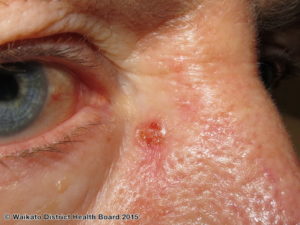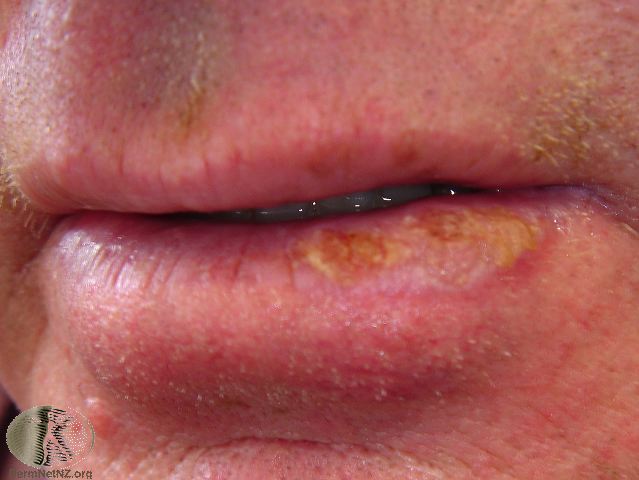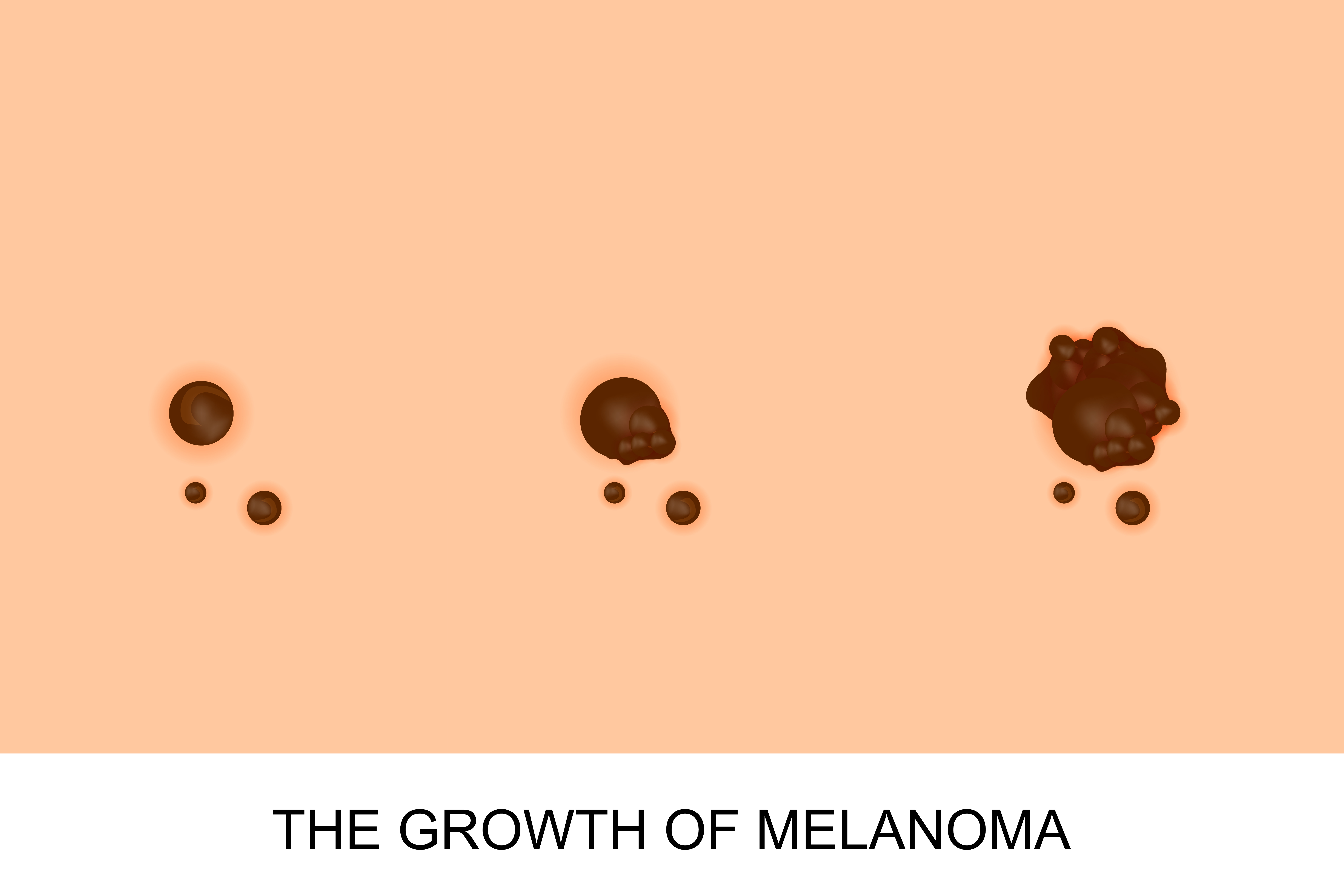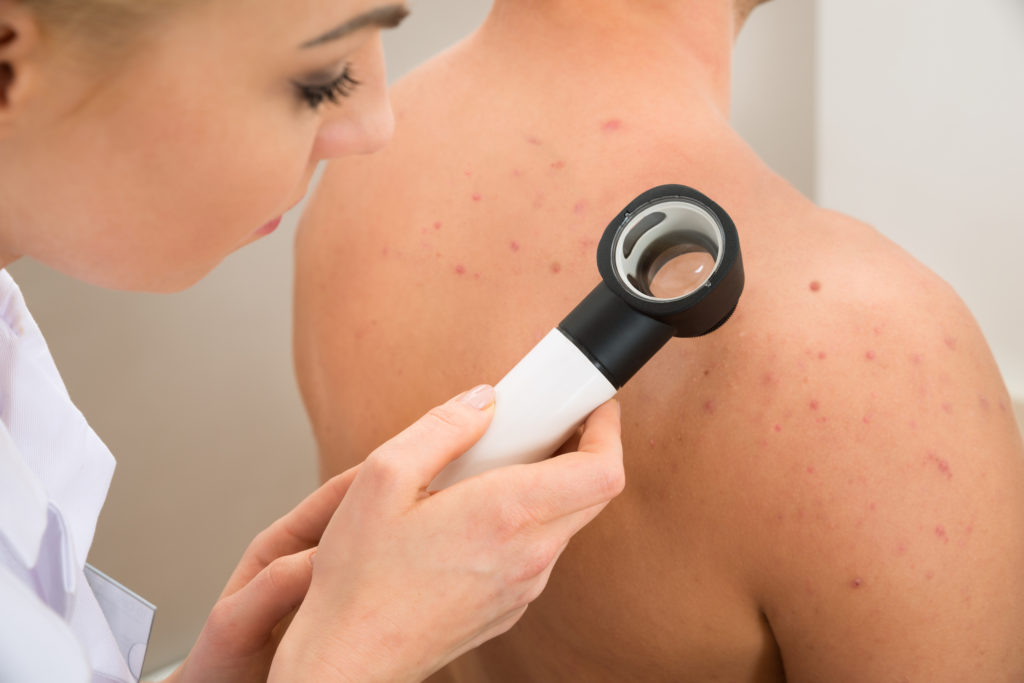Skin Cancer
Dr. Keith A. Knoell, Waynesboro, VA
Serves Waynesboro, Staunton, Lexington and Harrisonburg, VA
What Causes Skin Cancer?
With over 2,000,000 Americans diagnosed with skin cancer each year, it’s a serious problem. The good news is if skin cancer is detected early, it’s highly curable. The biggest cause, of course, is chronic over exposure to the sun.
That’s why we advocate the use of sunscreen. Use it every day, even on cloudy days!
The 3 Main Types of Skin Cancer
The most common types of skin cancer are basal cell carcinoma, squamous cell carcinoma, and melanoma.


Basal cell carcinoma
This is the most common type of skin cancer. It appears in many shapes and sizes.
- Sometimes you will see a dome-shaped growth with blood vessels visible.
- Other times, it is a shiny, pinkish patch
- It can appear as a sore that heals and returns
You’ll find basal cell carcinoma on areas of the skin
that get a LOT of sun exposure. The scalp, nose, neck, and hands
are typical areas.
photo courtesy www.dermnetnz.org
Although basal cell carcinoma rarely spreads to other areas of your body, it can grow deep into the bone and tissue.
Squamous Cell Carcinoma
This is the second most common skin cancer. You’ll find that, it too, takes many shapes.
- Sometimes it’s a crusted or rough bump
- You’ll also see it appear as a red, rough flat patch
- Or, a dome-shaped bump that grows and bleeds
- It can also appear as a sore that doesn’t heal, or heals and returns
Just like basal cell carcinoma, squamous cell carcinoma is the result of too much sun exposure, which is why you see it appear on the face, ears, lips, back of the hands, arms and legs.
Unlike it’s cousin, squamous cell carcinoma can appear on areas of the body not exposed to the sun. For example:
- Inside of your mouth
- On the genitals
Chewing tobacco or smoking may increase your risk of squamous cell carcinoma of the mouth or throat.
Seek treatment immediately! Left untreated, it can spread to other parts of the body, and that makes treatment difficult.
photo courtesy of dermnetnz.org


Melanoma
The most deadly form of skin cancer is melanoma. Although it appears most commonly on people with light colored skin, people of color can also contract it.
For dark skin types, melanoma appears on the palms of hands, soles of the feet, under a fingernail or toenail, in the mouth, or on the genitals.
Melanoma can develop on normal skin or from an existing mole. If you see a change in the shape, color, or size of a mole on your skin, or if the mole becomes painful, itchy, and bleeds, it’s time to seek immediate medical attention.
Under fingernails and toenails, melanoma appears as a black or brown streak. Dr. Knoell stresses that melanoma is almost 100% curable if it is caught in the early stages.
Warning Signs of Melanoma
Asymmetry
One half of the area does not look like the other half of the area.
Border
The border is irregular, scalloped, or is poorly defined.
Color
The color varies from one spot to another. Color shades range from tan and brown to black. You may also see colors of white, red, or blue.
Diameter
Melanomas are most often greater than the size of a pencil eraser or 6 millimeters! Of course, they can appear smaller, too. The point is, don’t take a chance. Get to our office quickly. The sooner treatment begins, the better.
Evolving
Do you have a mole or skin growth that has changed in size, shape, or color? If so, please make an appointment with us. Any type of skin growth that is different from the rest on your body is a skin cancer suspect.

Pre-Cancerous Skin Conditions
Actinic keratoses are also common skin growths The difference here is that they are considered pre-cancerous. Left untreated, these growths can turn into squamous cell carcinoma.
Most actinic keratoses are dry, scaly, rough-textured spots on the skin. They, too, form as a result of chronic skin exposure. You’ll find them on the head, lips, scalp, arms and hands.
Women frequently get actinic keratosis on the backs of their legs. And, it’s sneaky! It can form, disappear, and then re-appear.

What Does A Dermatologist Do To Treat Skin Cancer?
The first thing Dr. Knoell will do is perform a biopsy to determine that skin cancer is present.
Then there are four possible treatments. Dr. Knoell will talk with you about which procedure is right for you.
Excision—Removing the skin growth usually in our office.
Curettage and elecrotrodessication—Dr. Noell scrapes away the tumor, then uses electricity to destroy any remaining cancer cells.
Mohs surgery—Mohs, pronounced “moes,” is a specialized surgery that removes some types of skin cancer. For difficult to treat basal cell tumors, it offers the highest cure rate.
Cryosurgery—The uses of liquid nitrogen to freeze cancer cells, which causes them to die.
Set up an appointment today with Dr. Knoell to evaluate the skin conditions that concern you. You’re in the best hands possible! 540-221-6702